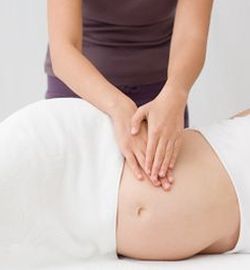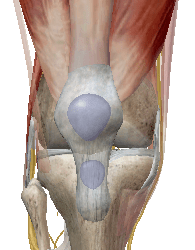 The knee joint is a hinge joint that allows for flexion and extension, as well as some internal and external rotation. It is formed by the articulations of the femur, tibia and patella.
The knee joint is a hinge joint that allows for flexion and extension, as well as some internal and external rotation. It is formed by the articulations of the femur, tibia and patella.
The knee joint is the largest joint in the body and due its complexity can be subject to many injuries and dysfunction.
Knee pain may be the result of:
- An injury to a ligament or an injury to the cartilage inside of the knee
- Muscular trigger points
- Muscular imbalances that create a tracking disorder of the patella
- Tendonitis
- Nerve irritation (this is common and often overlooked)
- Osteoarthritis
There are 4 important ligaments in the knee: 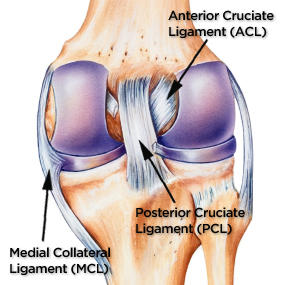
- The anterior crutiate ligament (ACL)- this ligament prevents the femur from sliding backwards on the tibia
- The posterior crutiate ligament (PCL)- this ligament prevents the femur from sliding forward on the tibia
- The medial and lateral collateral ligaments– they prevent the femur from sliding to either side of the tibia
The ACL is the most common ligament to be injured, especially in sports. A tear of the ligament can be caused by hyperextension of the knee, or forceful rotation or side-bending of the knee or direct trauma. The injury often coincides with damage to other structures in the knee, such as the medial or lateral collateral ligaments. Normally, a loud “pop” is heard at the time of the injury. Damage to the ACL often requires surgical repair.
The medial and collateral ligaments can be injured from impact to the inside or outside of the knee or twisting of the knee. For example, an impact to the inside of the knee will overstretch the lateral collateral ligament causing a sprain. The associated symptoms with ligament sprains depends upon the severity of the tear. If the damage is mild, there may be no swelling, but tenderness on the inside or outside of the knee. When there is more damage to either ligament, there is more swelling and pain present.
 In addition, there are 2 pieces of cartilage inside of the knee, the medial meniscus and the lateral meniscus, that function to absorb shock. A meniscus tear is a common injury, often caused by turning quickly with the foot planted and knee bent. As we age, each meniscus gets worn down, making it more susceptible to injury. Depending upon the grade of the injury, there could be mild to moderate swelling and pain. If a piece of the cartilage comes loose into the joint space, the knee will feel unstable and “wobbly”.
In addition, there are 2 pieces of cartilage inside of the knee, the medial meniscus and the lateral meniscus, that function to absorb shock. A meniscus tear is a common injury, often caused by turning quickly with the foot planted and knee bent. As we age, each meniscus gets worn down, making it more susceptible to injury. Depending upon the grade of the injury, there could be mild to moderate swelling and pain. If a piece of the cartilage comes loose into the joint space, the knee will feel unstable and “wobbly”.
Many muscles surround the the knee and can cause knee pain.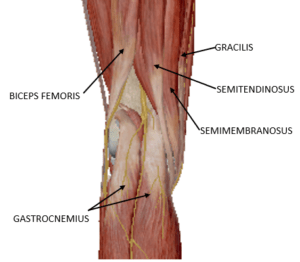
There are several muscles in the back of the knee (picture right) whose tension and active trigger points can cause knee pain.
The rectus femoris muscle, in the quadiceps group on the anterior thigh, has a strong tendon that attaches above and below the patella. The function of the rectus femoris is to extend the knee and assist in flexion of the hip. Tension in this muscle or overuse can lead to patella tendonitis (inflammation of the tendon) or tendonopathy (tendon degeneration). With either condition, pain can be felt below the knee cap where the tendon connects the patella to the tibia (shin bone). In the beginning, pain may only be felt before or after physical activity, but left untreated can cause pain with everyday movements. Massage therapy is very helpful in the treatment of patella tendonopathies. The goal of treatment is to reduce tension in the rectus femoris muscle and apply cross fiber friction massage to the tendon itself in order to promote healing.
An active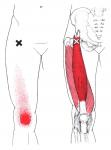 trigger point in the rectus femoris muscle (left) can also cause anterior knee pain. This trigger point can cause a deep, aching pain in the front of the knee that radiates into the upper thigh. Patients may also experience hip buckling from this trigger point.
trigger point in the rectus femoris muscle (left) can also cause anterior knee pain. This trigger point can cause a deep, aching pain in the front of the knee that radiates into the upper thigh. Patients may also experience hip buckling from this trigger point. 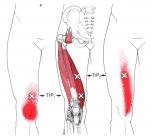
The vastus medialus muscle (right), another member of the quadriceps group, can house trigger points that causes medial knee pain, as well as inner thigh pain. The lower trigger point can also cause buckling of the knee.
A third muscle on the quadriceps group that causes knee pain is the vastus lateralis muscle (left). This is the largest muscle of the anterior thigh. Its primary actions are to extend the knee and to help you stand from a squatting position. It can be home to numerous trigger points that cause lateral knee pain as well as pain on the outside of the leg anywhere from the top of the hip to below the knee. The pain may be more pronounced with extended walking or going up stairs. Tension in this muscle may also cause the knee to “lock” on occasion.
muscle on the quadriceps group that causes knee pain is the vastus lateralis muscle (left). This is the largest muscle of the anterior thigh. Its primary actions are to extend the knee and to help you stand from a squatting position. It can be home to numerous trigger points that cause lateral knee pain as well as pain on the outside of the leg anywhere from the top of the hip to below the knee. The pain may be more pronounced with extended walking or going up stairs. Tension in this muscle may also cause the knee to “lock” on occasion.
Posterior knee pain may be caused by trigger points in the following muscles:
The gastrocnemius muscle is the most superficial muscle of your calf. It acts to plantar flex the ankle (as in standing on your tip toes) and assists in flexing the knee.
toes) and assists in flexing the knee.
Trigger points in the gastrocnemius can cause:
- Pain in back of the thigh above the knee
- Pain behind the knee
- Pain on the inside or outside of the knee
- Pain down the outside of the lower leg
- Pain in the bottom of the foot
- Cramps in the calf muscles
- Pain or discomfort behind the knee when walking uphill or upstairs
- Pain or cramping on the inside of the foot
 The biceps femoris muscle (left) is a member of the hamstring group in the posterior thigh. Its primary actions are to flex teh knee and assist in extension of the hip. Active trigger points in this muscle can cause posterior knee pain along with pain in the back of the leg and upper calf muscle. This pain may be felt sitting or walking. These
The biceps femoris muscle (left) is a member of the hamstring group in the posterior thigh. Its primary actions are to flex teh knee and assist in extension of the hip. Active trigger points in this muscle can cause posterior knee pain along with pain in the back of the leg and upper calf muscle. This pain may be felt sitting or walking. These trigger points may even bother you at night when you sleep.
trigger points may even bother you at night when you sleep.
The poplitius muscle (right) is a small muscle on the back of the lower leg. Its primary action is to unlock the knee when bending it from a fully straightened position. The trigger point in the poplitius muscle causes pain in the back of the knee that may increase when walking down stairs.
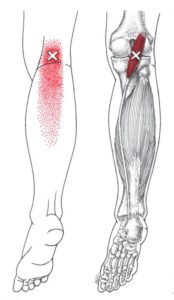 Another small muscle in the back of the knee is the plantaris muscle. This muscle has a long tendon that runs next to the achilles tendon. It helps to plantar flex the ankle and to flex the knee. An injury to this muscle is often referred to as Tennis Leg. If the muscle’s tendon is torn during activity, a noticeable “pop” will be heard. Pain and swelling will be present where the muscle meets the Achilles’ Tendon. Aside from injury, an active trigger point in the plantaris muscle can also cause pain on the back of the knee.
Another small muscle in the back of the knee is the plantaris muscle. This muscle has a long tendon that runs next to the achilles tendon. It helps to plantar flex the ankle and to flex the knee. An injury to this muscle is often referred to as Tennis Leg. If the muscle’s tendon is torn during activity, a noticeable “pop” will be heard. Pain and swelling will be present where the muscle meets the Achilles’ Tendon. Aside from injury, an active trigger point in the plantaris muscle can also cause pain on the back of the knee.
Iliotibial Band Friction Syndrome is a cause of knee pain frequently found in runners and cyclists. The iliotibial band (IT band) is a tendinous extension that runs from the gluteus maximus and tensor fascia latae muscles down to the outside of the tibia just below the knee. The tract extends the tensor fasciae latae muscle so that it can perform its functions of flexion, abduction and rotation on the thigh. It provides stabilization of the knee during walking, standing, running and cycling.
Pain on the outside of the knee as the knee bends and straightens is the primary symptom of IT Band Friction Syndrome. Treatment includes resting from activities and balancing flexibility and strength of the hips, knees, and leg muscles.
 Osteoarthritis of the knee is a common cause of knee pain over the age of 50. It is a progressively degenerative disorder that is caused by wear and tear of the cartilage within the knee.
Osteoarthritis of the knee is a common cause of knee pain over the age of 50. It is a progressively degenerative disorder that is caused by wear and tear of the cartilage within the knee.
Symtoms of Knee Osteoarthritis include:
- Pain that increases with activity
- Swelling or warmth in and around the joint
- Decreased range of motion of the knee
- Cracking sounds when moving the knee
- Morning stiffness of the knee joint or stiffness after you have been sitting for an extended amount of time
Massage therapy can be very helpful in the treatment of knee joint Osteoarthritis in the beginning stages by helping to balance the muscles that act upon the knee. By decreasing tension on the joint, it helps to prevent expedited degeneration. Many times, periostal trigger points (these are painful spots that form on the outer layer of the bone) on the knee are primarily responsible for the pain felt in and around the joint. Elimination of these trigger points by a qualified Medical Massage therapist brings substantial relief to the patient.
 Nerve irritation is another source of knee pain that is typically overlooked by health care professionals. Tension in low back muscles or hip muscles can slightly irritate nerves that innervate the leg. This slight irritation will not cause pain at the site of irritation, but rather somewhere along the path of the nerve. The knee is often affected. Simple compression tests are performed by your therapist to determine whether or not nerve irritation may be the source of your knee pain.
Nerve irritation is another source of knee pain that is typically overlooked by health care professionals. Tension in low back muscles or hip muscles can slightly irritate nerves that innervate the leg. This slight irritation will not cause pain at the site of irritation, but rather somewhere along the path of the nerve. The knee is often affected. Simple compression tests are performed by your therapist to determine whether or not nerve irritation may be the source of your knee pain.
A recent testimonial from a patient who presented with knee pain and the solution was in relieving pressure from the sciatic nerve:


